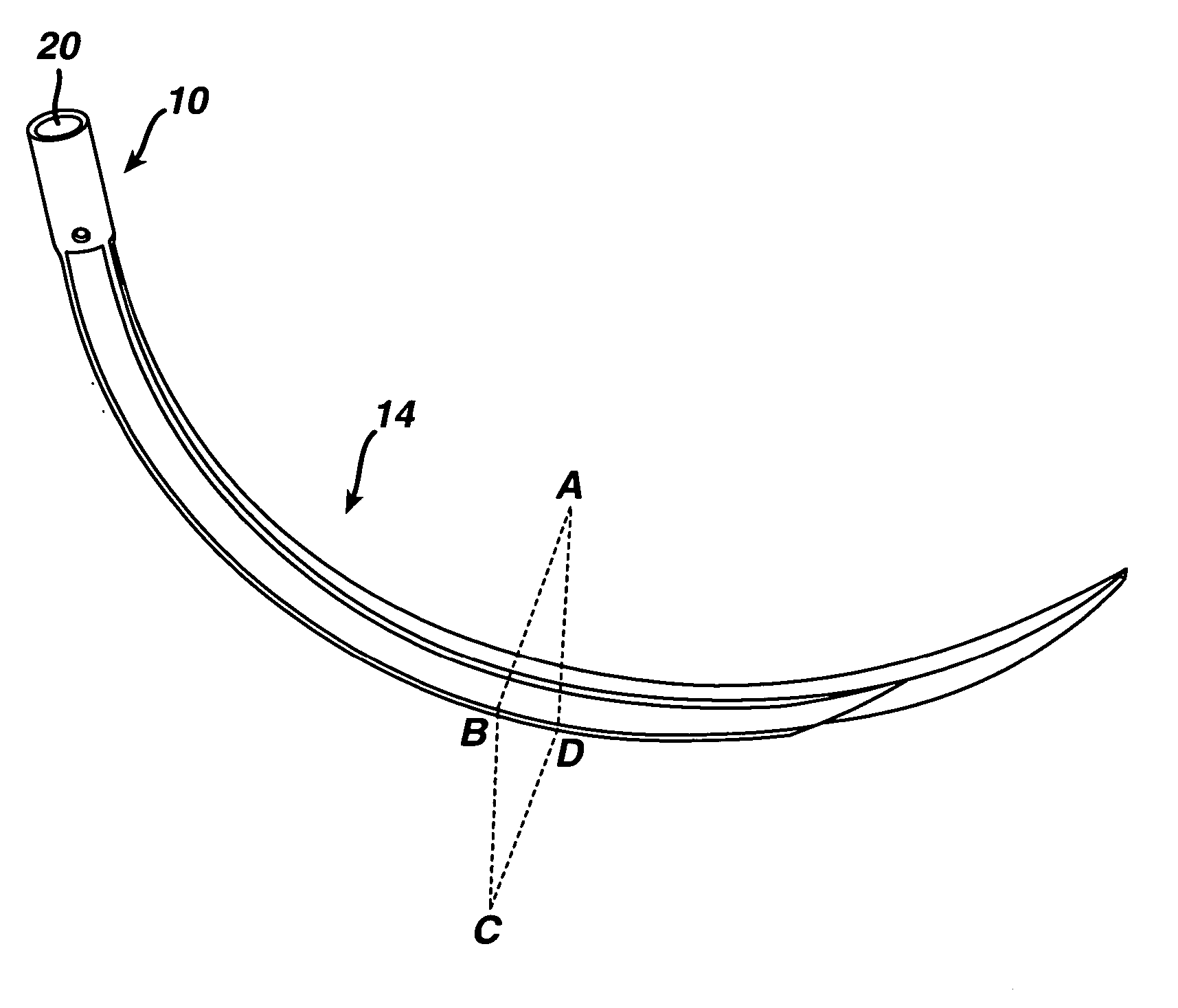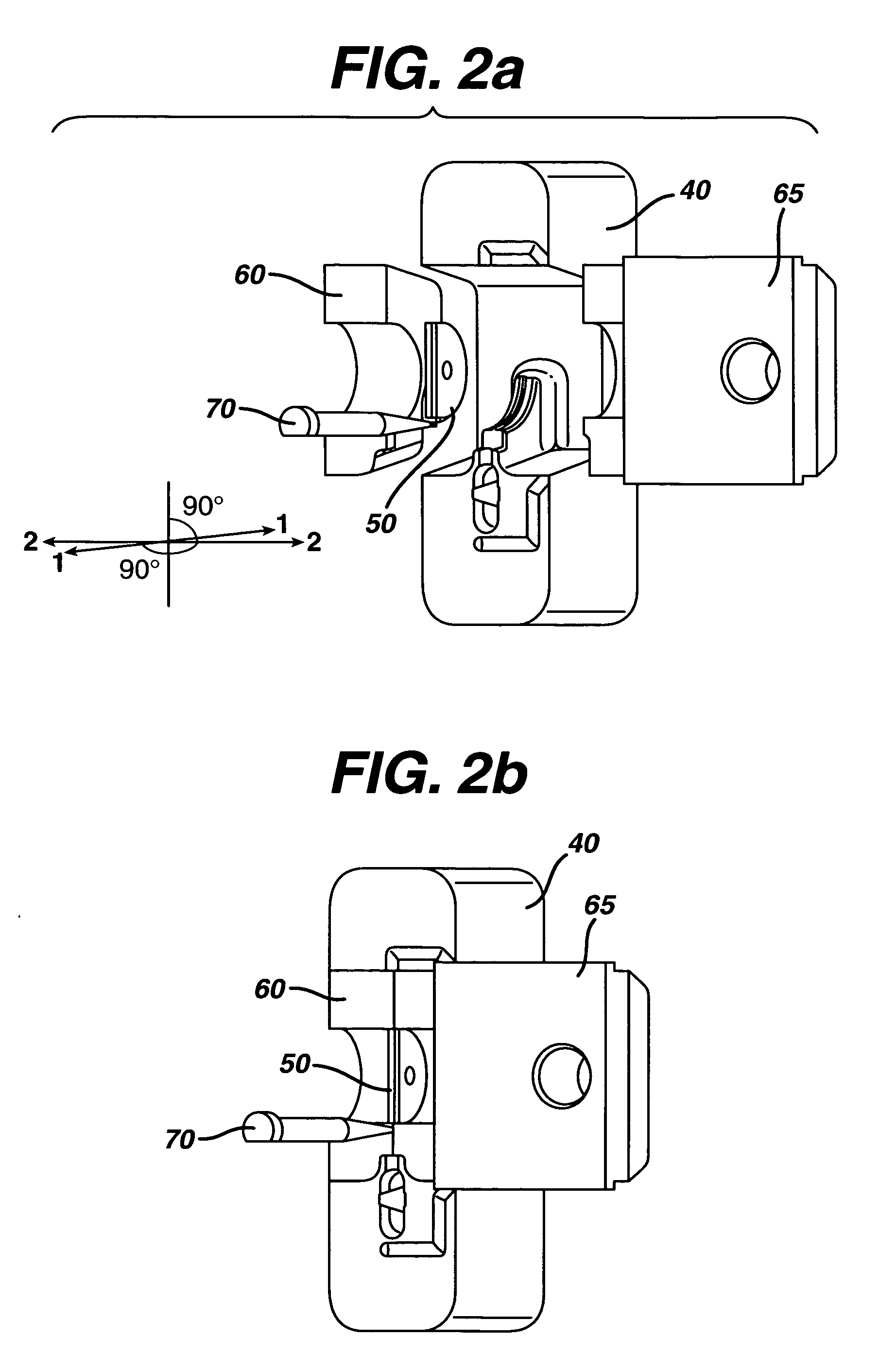Metal injection molded suture needles
- Summary
- Abstract
- Description
- Claims
- Application Information
AI Technical Summary
Benefits of technology
Problems solved by technology
Method used
Image
Examples
example 1
[0038] The needle that is schematically depicted in FIG. 1 was produced via metal injection molding. This needle has radiused or “undercut” cutting edge described by U.S. Pat. No. 5,797,961. The body portion is not round in cross-section but is rather rectangular with average dimensions of 0.0245″ by 0.0240″. In addition, as shown in FIG. 5, ribs have been molded into the inside and outside curvatures of the needle body. The proximal end of the needle shaft has an outside diameter of 0.030″ with an inside diameter of 0.024″ making it compatible with a size 2 suture according to United States Pharmacopia, USP, standards. The mold components used to produce this needle are shown in FIGS. 2, 3 and 6. Needles were molded from two different feedstock materials. The first feedstock contained the constituent powders of a martensitic stainless steel, commonly referred to as 420 grade. The other feedstock contained the constituent powders of a matensitic-aged, or mar-aged, stainless steel, c...
example 2
[0039] The suture needle schematically depicted in FIG. 7 was produced via MIM. This suture needle exhibits a standard cutting tip with three cutting edges 210 and flat faces 220 that taper to a point from the needle body, as shown in FIG. 9a. The needle body has ribs 240 as schematically depicted in FIG. 9b, which represents the cross-sectional view taken along E-F-G-H in FIG. 7. The height 250 and width 260 of the needle body were 0.0392″ and 0.0416″ respectively. The suture receiving hole 250 in FIG. 7, was 0.0060″ deep with an inside diameter of 0.0202″ and was able to accommodate a size 0 and 2-0 suture, referring USP standards. The four mold components used to form this needle, a core 255 and cavity 265, slide 275 and core pin 280, are shown in FIG. 10a in the open position. The mold components move from the open position schematically depicted in FIG. 10 a to closed position shown in FIG. 10b. A close-up view of the mold with the suture needle 285 included is shown in FIG. 11...
example 3
[0040] Suture needles produced from 420 stainless steel feedstock under the processing parameters described in Example 2 exhibited up to 6 volume percent internal porosity after the sintering process. A micrograph taken of the MIM needle described in Example 2 after the sintering process, but before a hot isostatic pressing process is shown in FIG. 12a. The black phase 300 is porosity and the light phase 310 is dense metal. The pores are evenly dispersed, ranging in size from a few micrometers to ˜50 micrometers. After subjecting the needles to a hot isostatic pressing process, wherein they were processed at 1100° C. for 3 hours under 104 MPa of gas pressure in an argon environment, the porosity was reduced to less than 1 volume percent. As shown in the optical micrograph of FIG. 12b, no dark phase is detectable indicating that the porosity was essentially eliminated. An improvement in ductility coincided with the decrease in internal porosity. As indicated by the dashed curve 350 i...
PUM
| Property | Measurement | Unit |
|---|---|---|
| Length | aaaaa | aaaaa |
| Fraction | aaaaa | aaaaa |
| Porosity | aaaaa | aaaaa |
Abstract
Description
Claims
Application Information
 Login to View More
Login to View More - R&D
- Intellectual Property
- Life Sciences
- Materials
- Tech Scout
- Unparalleled Data Quality
- Higher Quality Content
- 60% Fewer Hallucinations
Browse by: Latest US Patents, China's latest patents, Technical Efficacy Thesaurus, Application Domain, Technology Topic, Popular Technical Reports.
© 2025 PatSnap. All rights reserved.Legal|Privacy policy|Modern Slavery Act Transparency Statement|Sitemap|About US| Contact US: help@patsnap.com



